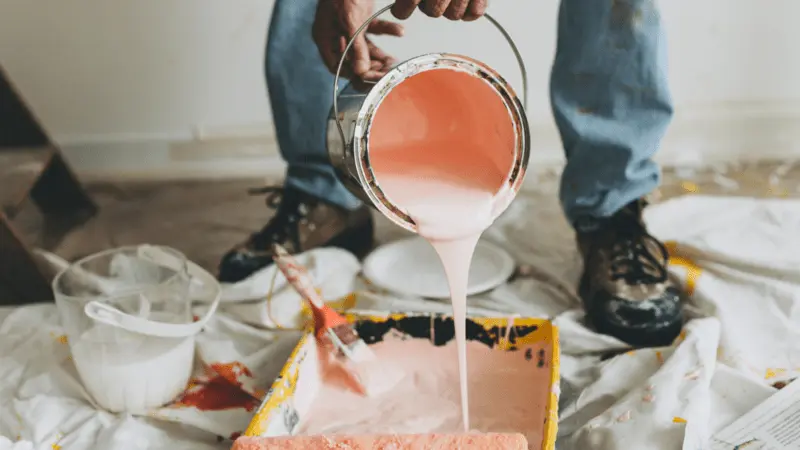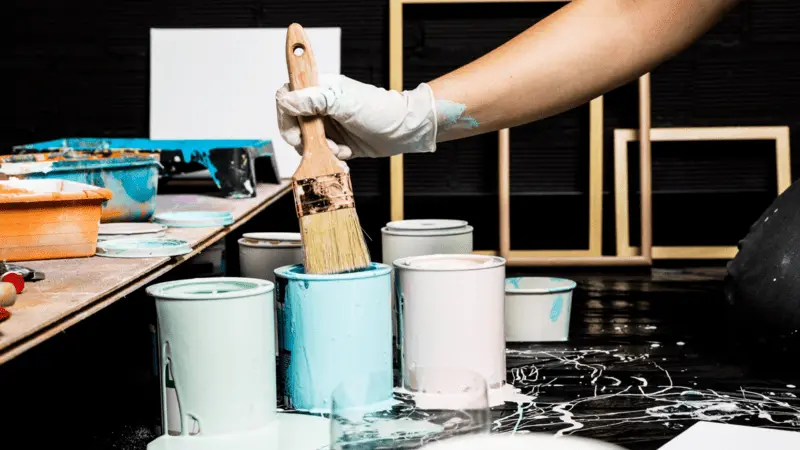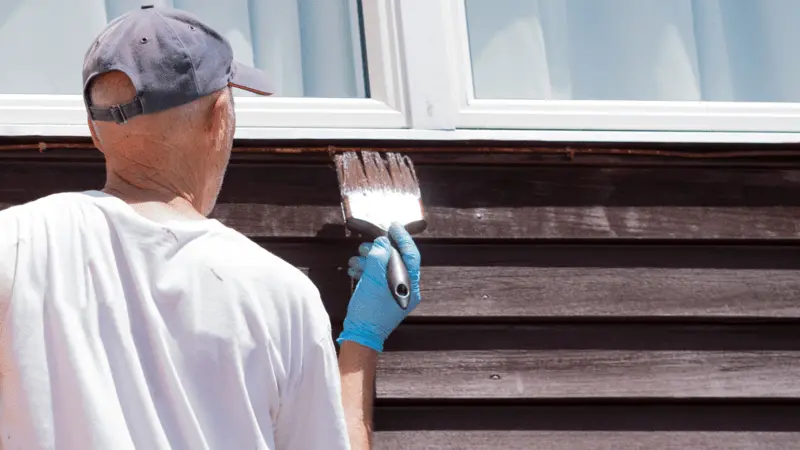Launching an exterior house painting project is a transformative endeavor that can breathe new life into your home’s appearance and enhance curb appeal. Yet, determining the right quantity of paint needed is often perplexing. Let’s unravel the mystery of “How many litres of paint to paint a house exterior?”
From measuring the surface area to considering paint coverage rates and accounting for multiple coats, we will provide a step-by-step roadmap to ensure your project proceeds smoothly.
| Exterior Component | Approximate Amount of Paint (Litres) |
|---|---|
| Doors | 1/4 gallon or 1 litre per door |
| Eave Linings | 10 – 14 litres for a carport |
| Gutters & Fascia’s | 4 litres |
| Walls (Smooth Surface) | 30 – 40 litres |
| Windows | 4 litres per window |
| Total Estimate for an Average 3-Bedroom Single-Story House | Approximately 60 litres |
How Many Litres Of Paint To Paint A House Exterior?

To determine how many liters of paint you will need to paint the exterior of a house, you can use the approximate estimates provided for each component and then add them up. Remember that these figures are based on an average single-story house, including a 3-bedroom with two coats of paint application.
Here’s the breakdown:
- Doors: 1/4 gallon or 1 liter of paint per door.
- Eave Linings (with a carport): 2 – 3 gallons or 10 – 14 liters of paint.
- Gutters & Fascia’s: 1 gallon or 4 liters of paint.
- Walls (for a smooth surface): 8 – 10 gallons or 30 – 40 liters of paint.
- Windows: 1 gallon or 4 liters of paint per window.
Now, add up the paint quantities needed for each component:
- Doors: 1 door x 1 liter = 1 liter
- Eave Linings: 12 liters (assuming the average of 2.5 gallons)
- Gutters & Fascia’s: 4 liters
- Walls: 35 liters (assuming the average of 9 gallons)
- Windows: 8 liters (assuming 2 windows)
Total: 1 liter + 12 liters + 4 liters + 35 liters + 8 liters = 60 liters
So, you would need approximately 60 liters of paint to paint the exterior of an average 3-bedroom single-story house with two coats of paint application.
Calculating Paint Needed for Exterior Painting

Repainting the exterior of your home can significantly enhance its curb appeal and protect it from the elements. However, to tackle this project, it’s crucial to calculate the amount of paint needed accurately. This guide will help you determine the correct quantity of paint required for your exterior painting endeavor.
Evaluate the Exterior Surface Area
Begin by measuring the surface area of all the walls you intend to paint. This includes measuring the width and height of each wall and then calculating the total square footage. Divide them into measurable sections (e.g., rectangles, triangles) for more complex surfaces and calculate their areas. Add these areas to obtain the total exterior surface area to be painted.
Consider Openings and Non-Paintable Areas
Windows, doors, and other non-paintable areas must be excluded from the total surface area. Measure and calculate the square footage of these areas and subtract them from the entire exterior surface area. This will give you a paintable surface area.
Account for Porous or Rough Surfaces
Porous or rough surfaces absorb more paint. You may need additional paint if your exterior walls have such a texture. Consult with a paint professional or the paint manufacturer for specific recommendations on coverage for different surface types.
Determine the Paint Coverage Rate
The coverage rate of paint varies based on its type, brand, and quality. High-quality paints typically cover more area per gallon. Check the manufacturer’s label for the coverage rate, usually square feet per gallon. Multiply this coverage rate by the number of gallons in a paint can to determine the coverage for that can.
Calculate the Paint Needed
Calculate the cost per gallon of paint by dividing the total paintable surface area by the coverage rate per gallon. The number of gallons of paint needed for one application may be roughly estimated using this method. Multiply this by the number of layers you wish to apply.
Consider Multiple Coats
Decide whether you’ll apply one or more coats of paint. Most exterior painting projects involve at least two primer and top coats. Calculate the paint needed for each coat separately using the coverage rate.
Account for Primer and Special Requirements
If using a primer, calculate the amount needed based on the primer’s coverage rate and the surface area. Additionally, consider any special requirements, like a tinted coat for a specific finish, and adjust the paint quantity accordingly.
Adjust for Overspill and Wastage
Account for potential overspill, wastage, and touch-ups that may be needed during the painting process. Extra paint is better than running out midway through the project.
Utilize a Paint Calculator for Precision
Consider using an online paint calculator from manufacturers or retailers to simplify the calculations. These tools can help you quickly and accurately determine the amount of paint needed for your exterior painting project.
Consult a Paint Professional for Expert Advice
Contact a paint professional company like InexMax, if you need more clarification on any step of the calculation process or need advice on paint selection and quantities. They can provide valuable insights and ensure you have a successful painting project.
Factor Affecting Exterior Painting Amount
Estimating the amount of paint required for an exterior painting project is a crucial aspect that demands accuracy. Running out of paint midway can result in an uneven finish and project delays. Several factors contribute to determining the amount of paint needed, ensuring a successful and efficient painting endeavor. Here are the key factors that influence the calculation of paint quantities for an exterior painting project:
Property Size
The size of your property plays a significant role in determining the amount of paint needed. Measuring the length and height and excluding unpainted areas such as windows and doors helps estimate the total square meters to be painted. The dimensions and areas you intend to paint directly impact the required amount.
Paint Coverage
The coverage of the paint you choose is a critical factor. Different types of paint offer varying coverage rates, usually specified in square meters per liter. For instance, masonry paint typically covers 8-10 square meters per liter on a flat surface. Understanding the chosen paint’s coverage rate helps calculate the project’s necessary quantity accurately.
Coat Count Needed
Determining the number of coats needed is essential for calculating the total amount of paint. Some surfaces may require multiple coats to achieve the desired finish and durability. Assess the paint’s specifications and recommendations regarding the number of coats required for optimal performance.
Calculating The Total Paint
Once you have the square meterage of the area to be painted, the coverage rate of the paint, and the required number of coats, you can calculate the total paint needed. For instance, consider a 100m² detached home with 8 windows and 2 doors. If the chosen masonry paint covers 5m² per liter on a flat surface and you plan for a two-coat application, you’ll need to calculate the required liters of paint accordingly.
You can accurately determine the paint needed for your exterior project by carefully considering these factors and performing the necessary calculations. Using paint calculators or seeking professional assistance can provide further guidance in ensuring a successful and well-planned painting project. Always aim for a precise estimation to achieve a satisfactory and visually appealing result.
Tips To Paint Your Exterior

Painting the exterior of your home can transform its appearance and enhance its curb appeal. Here are some essential tips to help you achieve a successful exterior painting project:
Prepare the Surface:
Proper surface preparation is key to a successful paint job. Clean the exterior thoroughly to remove dirt, grime, and loose or flaking paint. Repair cracks, holes, or damaged areas using appropriate fillers and sealants. Sand rough surfaces to create a smooth base for the paint.
Choose the Right Paint:
Select high-quality exterior paint for your specific surface, weather conditions, and climate. Consider factors such as durability, resistance to fading, and ease of application. Opt for paint that provides good coverage and is designed for exterior use.
Test Colors:
Test your chosen paint colors on a small, inconspicuous area of your home to ensure you’re happy with the shade and finish. Natural lighting can significantly influence how colors appear, so assess them in different lighting conditions before making a final decision.
Use Quality Tools and Equipment:
Invest in good-quality brushes, rollers, and other painting tools. High-quality tools ensure smoother application and a better finish. Depending on the surface, you may need specific brushes or sprayers designed for exterior use.
Protect Surrounding Areas:
Cover nearby plants, landscaping, and surfaces you intend to paint with something other than drop cloths or plastic sheets. Use painter’s tape to protect windows, door frames, and other areas you don’t want to paint.
Apply Primer:
Use a primer to prepare the surface and ensure proper paint adhesion. Primer helps the paint adhere better, enhances durability, and can improve the overall finish.
Follow Proper Painting Techniques:
Begin painting from the top and work your way down. Apply paint evenly, using long, smooth strokes. For larger areas, use a roller for faster and more consistent coverage. Always follow the manufacturer’s recommendations regarding drying times and re-coating.
Allow Adequate Drying Time:
Ensure each coat of paint is completely dry before applying the next coat. Rushing the process can result in a patchy finish and compromise the paint’s durability.
Apply Multiple Coats:
Two coats of paint are typically recommended for a more even and long-lasting finish. Allow the first coat to dry thoroughly before applying the second.
Frequently Asked Questions
1. How Do I Calculate The Amount Of Paint Needed For The Exterior Of My House?
To calculate the amount of paint needed, measure the surface area and consider the paint coverage rate you intend to use. Multiply the surface area by the coverage rate and adjust for the number of coats you plan to apply.
2. Is There A Standard Paint Coverage Rate For Exterior Surfaces?
Paint coverage rates vary based on the type and brand of paint. Typically, masonry paint covers a flat surface of about 8-10 square meters per liter. However, the coverage rate may vary for different types of surfaces and paint brands.
3. Can I Dilute The Paint To Cover A Larger Area With The Same Amount Of Paint?
Diluting paint can increase coverage but may affect its performance and durability. It’s advisable to follow the manufacturer’s instructions and only dilute the paint below the recommended levels.
4. In The Paint Calculation, How Do I Account For Doors, Windows, And Other Non-Paintable Areas?
Measure the areas of doors and windows separately. Subtract these areas from the total surface area to be painted to obtain the accurate paintable surface area. Use this adjusted surface area to calculate the paint needed.
5. Should I Purchase Extra Paint For Unexpected Needs During The Project?
Yes, purchasing a little extra paint to account for touch-ups, wastage, or any unexpected needs during the painting process is a good practice. Having a buffer of paint ensures that you complete the project without interruptions.
Need Exterior Painting Services? Welcome To Inexmax!
On the quest for superior exterior painting solutions? Discover the answer at Brisbane’s hub of excellence – InexMax in Queensland. Over the past ten years, InexMax has not only reshaped but elevated the painting landscape, raising the bar for quality and customer satisfaction. Our approach is rooted in transparency, originality, and an unwavering dedication to achieving aesthetic brilliance. Through their expertise and inventive flair, InexMax can help transform your exterior. Witness the impactful transformation that a touch of paint, coupled with InexMax’s expertise, can bring.
